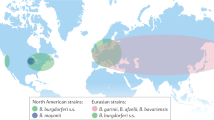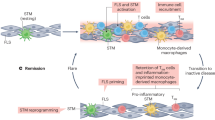Abstract
It has been hypothesized that a persistent intraarticular viral infection might play an important part in the pathogenesis of chronic arthritis. However, it remains unclear how such an infection could survive in synovial cells that express large amounts of HLA-DR and inter-cellular adhesion molecule-1 (ICAM-1) by which they communicate with immunocompetent cells. In an in vitro model of persistent mumps virus infection of synovial cells, results suggested that, in contrast to mock-infected cells, cells containing viral antigen did not express HLA-DR in response to interferon-gamma and that they did not up-regulate ICAM-1 expression under these conditions. Previously it has been shown that infected synovial cells do not express viral surface antigens. By these mechanisms, infected cells, interspersed among a large majority of uninfected cells, might evade recognition and eradication by the the immune system. Lack of neoantigen expression on infected cells might be an important viral strategy to maintain a persistent infection and to initiate and perpetuate joint inflammation.
Similar content being viewed by others
References
Maksymowych WP, Glass DN (1988) Population genetics and molecular biology of the childhood chronic arthropathies. Baillieres Clin Rheumatol 2:649–671
Harris ED (1990) Rheumatoid arthritis, pathophysiology and implications for therapy. N Engl J Med 322:1277–1289
Sewell KL, Trentham DE (1993) Pathogenesis of rheumatoid arthritis. Lancet 341:283–286
Chantler JK, Tingle AJ, Petty RE (1985) Persistent rubella virus infection associated with chronic arthritis in children. N Engl J Med 313:1117–1123
Huppertz HI, Miki NP, Chantler JK (1991) Susceptability of normal human joint tissue to viruses. J Rheumatol 18:699–704
Huppertz HI, Chantler JK (1991) Restricted mumps virus infection of cells derived from normal human joint tissue. J Gen Virol 72:339–347
Gordon SC, Lauter CB (1984) Mumps arthritis: a review of the literature. Rev Infect Dis 6:338–344
Oldstone MB (1989) Viral persistence. Cell 56:517–520
Burmester GR, Dimitriu-Bona A, Waters SJ, Winchester RJ (1983) Identification of three major synovial lining cell populations by monoclonal antibodies directed to Ia antigens and antigens associated with monocytes/macrophages and fibroblasts. Scand J Immunol 17:69–82
Haas JP, Andreas A, Rutkowski B, Brunner H, Keller E, Hoza J, Havelka S, Sierp G, Albert ED (1991) A model for the role of HLA-DQ molecules in the pathogenesis of juvenile chronic arthritis. Rheumatol Int 11:191–197
Hale LP, Martin ME, McCollum DE, Nunley JA, Springer TA, Singer KH, Haynes BF (1989) Immunohistologic analysis of the distribution of cell adhesion molecules within the inflammatory synovial microenvironment. Arthritis Rheum 32:22–30
Chin JE, Winterrowd GE, Krzesicki RF, Sanders ME (1990) Role of cytokines in inflammatory synovitis. Arthritis Rheum 22:1776–1786
Haynes BF, Grover BJ, Whichard LP, Hale LP, Nunley JA, McCollum DE, Singer KH (1988) Synovial microenvironment-T cell interactions: human T cells bind to fibroblast-like synovial cells in vitro. Arthritis Rheum 31:947–955
Firestein GS, Zvaifler NJ (1987) Peripheral blood and synovial fluid monocyte activation in inflammatory arthritis. Arthritis Rheum 30:864–871
Parkkonen P, Hyoty H, Koskinen L, Leinikki P (1992) Mumps virus infects beta cells in human fetal island cell cultures upregulating the expression of HLA class I molecules. Diabetologia 35:63–69
Panayi GS (1992) The immunopathogenesis of rheumatoid arthritis. Clin Exp Rheumatol 10:305–307
Firestein GS, Zvaifler NJ (1990) How important are T-cells in chronic rheumatoid synovitis? Arthritis Rheum 33:768–773
Remmers EF, Sano H, Lafyatis R, Case JP, Kumkumian GK, Hla R, Maciag T, Wilder RL (1991) Production of platelet derived growth factor B chain mRNA and immunoreactive PDGF-B-like polypeptide by rheumatoid synovium: coexpression with heparin binding acidic fibroblast growth factor-1. J Rheumatol 18:7–13
Shiozawa S, Tokuhisa T (1992) Contribution of synovial mesenchymal cells to the pathogenesis of rheumatoid arthritis. Semin Arthritis Rheum 21:267–273
Steere AC, Duray PH, Butcher EC (1988) Spirochetal antigens and lymphoid cell surface markers in Lyme synovitis. Arthritis Rheum 31:487–495
Author information
Authors and Affiliations
Rights and permissions
About this article
Cite this article
Huppertz, H.I. How could infectious agents hide in synovial cells? Possible mechanisms of persistent viral infection in a model for the etiopathogenesis of chronic arthritis. Rheumatol Int 14, 71–75 (1994). https://doi.org/10.1007/BF00300250
Received:
Accepted:
Issue Date:
DOI: https://doi.org/10.1007/BF00300250




